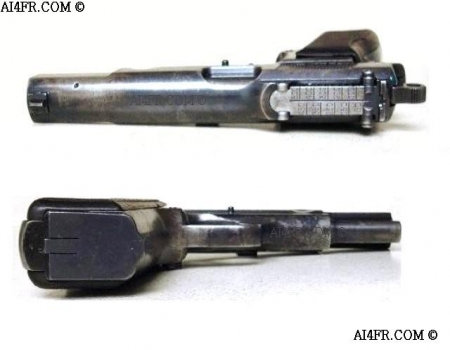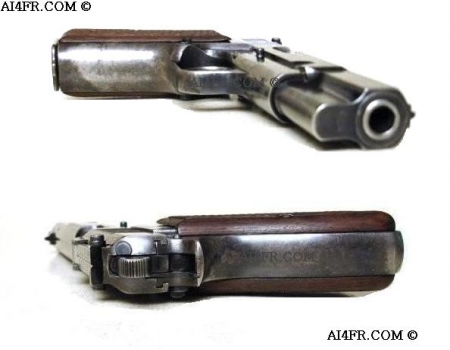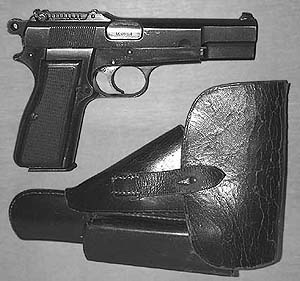Nazi Browning High Power Serial Numbers
Welcome to my overview due to the variety of pistols for the German Wehrmacht. Serial numbers: 45000 The FN M1935 High Power is split in 2 major.



The Browning High Power Pistol was the last of John Browning s pistol designs he worked on from 1914 till his death in 1926. In essence this model is considered a.
69C1000 A 1969 Hi-Power pistol with a serial number of manufactured in 1976 with the serial number 01001. 1998: In 1998 Browning redid the.
This Browning Hi-Power model 640 b was manufactured at the Fabrique Nationale d Armes de Guerre or National Factory of Weapons of War in Herstal Belgium or simply FN for short, some time in late 1941 or early to middle of 1942. It is a self-loading pistol that operates by using a short recoil, delayed locking block system. The Hi-Power is a semi-automatic pistol that has been chambered for the. 9mm Parabellum cartridge. The pistol has been designed to operate as a single action firearm that utilizes an external hammer. The pistol is made form steel and has a blued finish. The sights include an inverted V shaped blade front sight that is drift adjustable for windage, and a V notch rear tangent sight that is finger adjustable for elevation out to 500 meters. The pistol is fed by a double column 13 round detachable box magazine and utilizes a push button magazine release that is located at the bottom left side rear corner of the trigger guard. An empty magazine will not eject from the pistol under its own weight. The pistol also features a manual thumb safety located on the frame at the top rear of the left grip. The pistol has a 4.40 inch barrel with 6 grooves using a right hand twist. The pistol has an overall length of 7.72 inches and an unloaded weight of 34 ounces. This firearm does employ a slide hold open mechanism to inform the operator that the last round has been fired. The diamond checkered grip panels are made from walnut.
This firearm design is based in part on the ideas of the American firearms inventor John Browning, and was later patented by Fabrique Nationale FN. It all started on May 9, 1921 when the French military authorities contacted a Belgium arms manufacturer known as Fabrique Nationale D Armes de Guerre of Herstal, Belgium or National Factory of Weapons of War located in Herstal, Belgium. The French requested a new service pistol that they called the Grand Rendement, French for High Yield, or alternatively Grande Puissance which literally translated means high power. The requirement set forth by the French military for the firearm was that it had to be compact, have a capacity of at least 10 rounds, a magazine disconnect device, an 8 inch barrel, 600 meter adjustable rear sight, an external hammer, a positive safety, and be capable of killing a man at 50 meters which meant that it needed to be chambered in. 9mm or larger with a projectile mass of around 8 grammes, and a muzzle velocity of 1150 feet per second. It was to accomplish all of this at a weight that was not to exceed 2.2 pounds. The pistol must also be able to accept a detachable shoulder stock.
John Browning did not get involved until the magazine was perfected by Dieudonne Saive who was John Browning s assistant and employed at Fabrique Nationale at the time. With the magazine in hand, Browning built two different prototypes for the project. One was a simple blowback design, while the other was striker fired and operated with a locked-breech recoil system. It was the locked breech striker fired design that was selected for further development and testing. Working with the Versailles Trial Commission the design was refined. The first pistol design was called the FN Browning Model 1922. French trials of this pistol lead to the subsequent FN Browning Model 1923 and then the later Browning Model 1924 that was fitted with an external hammer. John Browning died in 1926 before he could finish the design. In 1928 after a number of Colt 1911 patents had expired, Dieudonne Saive redesigned the firearm by combining it with the best features of the 1911. Even though John Browning had nothing what so ever to do with the redesign of the pistol, and had in fact been dead for nearly two years, the pistol still bore the great inventor s name and was known as the FN Browning Model 1928. By 1931 the removable breech bolt was abandoned, and a take down system featuring a removable muzzle bushing much like that of the 1911 was initially incorporated as well as a curved rear grip strap and a 13 round double stacked magazine. By 1934, the Hi-Power design was complete and ready to be produced. France decided not to adopt the pistol, instead selecting the conceptually similar Mle. 1935 that was developed by the Swiss designer Charles Petter. The Browning Hi-Power was first adopted by Belgium for military service in 1935 as the Browning P-35. At this time it was also adopted by China, Latvia, Lithuania and Peru, but only 56,000 pistols were manufactured by FN before the German army invaded Belgium and Holland on May 10, 1940.
The Hi-Power pistol has been known by several names through out its history. It is often referred to as simply HP which is short for Hi-Power or High-Power or as GP which is short for the French term, Grande Puissance which literally translated means high power. The Irish called it the BAP which is short for Browning Automatic Pistol. It is also known as the P-35 which is based on the introduction of the pistol in 1935. During the Nazi occupation of Belgium in 1940, the Germans gave it the name Pistole Modell 640 b, the b stood for belgisch or Belgian. Some have even called it the King of Nines. In Canada it was called the No.1 MK I and later the No.2 MK I. It originally received the Hi-Power name due to it having the first functional double column 13 round magazine, which was nearly twice that of contemporary sidearm designs of the time. With a full magazine and a cartridge loaded in the chamber, the Hi-Power is able to achieve 14 rounds of continuous fire before the pistol was in need of reloading. Which is an amazing amount of firepower over other pistol designs that was used in WWII such as the U.S. 1911A1, the German Luger, the Japanese Nambu, and the Russian M1895 revolver.
The Allied Hi-Power pistols that were made by John Inglis and Company during WWII were often used for covert operations and commando groups including the U.S. Office of Strategic Services OSS and the British Special Air Service SAS. After the war, Hi-Power pistols have remained popular with many military forces from around the world and over 93 nations have officially issued this sidearm to its troops since its invention. Even the former Iraqi ruler Saddam Hussein and his military officers were seen armed with a Hi-Power pistol. Three quarters of a century after its first introduction into military service, the Hi-Power is still in use by many nations to this very day. The weapon is either in use by, or is the standard sidearm of the following countries, the Argentine Army, Australian Defense Force, Belgian Army, British Army, Canadian Armed Forces, Indian Army, Irish Army, Israeli police, Luxembourg Army, Singapore Special Operations Force and the Venezuelan Army, among others. Many firearms enthusiast consider the Hi-Power an improved design by John Browning over his famous M1911 pistol.
German manufactured Hi-Power pistols.
The Hi-Power pistols that were accepted by the German military will have one of three Waffenamt stampings or Weapons Office inspectors stamps found on them. These would be WaA 103, WaA 140, and/or WaA 613 The Germans manufactured over 315,000 of the Hi-Power pistols during their occupation of Belgium.
The Germans knew right away what they had procured in the way of the Belgian FN plant in 1940. The Belgians knew this as well from the past experience with the Germans in the first world war. Many of the Belgian employees and factory workers gave the Germans such a hard time back in 1914, that the Germans gave up on the idea of having the Belgians manufacture arms for them during WWI. In fact, the Germans turned the FN arms plant into an automobile workshop for the duration of WWI. With this knowledge behind them, the Germans quickly set-up shop and began manufacturing weapons at the FN plant. Several models of pistols were manufactured at FN under German control during WWII such as the Pistole modell 641 b, the 626 b and the one featured on this page, the 640 b. The b was an abbreviation for belgisch or Belgium. It is thought that the following amounts of 640 b pistols were made by the Germans.
1940. 8,500
1941. 65,700
1942. 80,600
1943. 101,200
1944. 63,000
When the Germans first started to manufacture the Hi-Power pistol in the 1940 s, the pistols had all of the features that the original designers had intended for it. As the war progressed, the Germans started to do away with what they felt were non-essential components. Most of the very first pistols, a few thousand, were manufactured from captured parts and had a highly polish blued finish along with the shoulder stock slot and the tangent rear sight. The first item to go was the slot in the backstrap for the shoulder stock. The next item to go was the tangent rear sight. Examples with serial numbers around 145,000 have been confirmed by collectors to have both the shoulder stock slot and the tangent rear sight removed. To further speed productions, the quality of the finish on the pistols were reduced from blue to a dull blue, followed by a progressively less polished and machined metal surfaces.
WaA 613 The very first Hi-Powers with the slotted shoulder stock cut and the tangent rear sight will be marked with the Waffenamt stamp WaA 613 and were manufactured from from May 1940 until early in 1941 with a serial number range of 44,500 through 65,200.
WaA 103 The next group of Hi-Powers were made from January of 1941 until May of 1942 and will be marked with the Waffenamt stamp WaA 103. Some reports claim that the WaA 103 marked Hi-Powers were only made during 1941 so the research is still ongoing. These pistols will be found with the tangent rear sight but no shoulder stock slot. They fall into the serial number range of 65,200 to 95,000.
WaA 140 The third and final German WWII era made Hi-Powers will be found with the Waffenamt stamp WaA 140. These WaA 140 stamped pistols were manufactured from late 1941 until the liberation of the FN plant in Belgium in 1944. None of these pistols will have the shoulder stock slot, but the early made examples in the serial number range of 95,000 to 135,000 will have the tangent rear sight. When the tangent rear sight was removed, the Germans replaced it with a fixed rear sight that was drift adjustable for windage only. It appears that the first of these WaA 140 marked fixed rear sight pistols begin at around the serial number of 150,000 which leaves a gap in the serial number range between the tangent and fixed sight WaA 140 marked pistols.The fixed sight WaA 140 marked pistols continued until around serial number 200,000 which dates them toward the end of 1942. At the beginning of 1943, a new serial code numbering system is used which began at number 01a until number 99999a was reached. Then at the beginning of 1944 the serial number 01b began and continues to about 6300b, at which time German production ceased due to the liberation of the FN factory. All of the letter suffixed serial numbered pistols will be found with the fixed rear sight.
The Hi-Power is the only sidearm that this author is aware of that was officially issued to both sides during WW2. Nazi Germany acquired Hi-Power pistols that were manufactured in occupied Belgium, while the Allies used the Hi-Power pistols that were manufactured in Canada by the Inglis company.
The Fabrique Nationale firm is still in business today and is a subsidiary of the Herstal Group. The company now owns the Winchester U.S. Repeating Arms Company as well as the Browning Arms Company which was founded by the family of John Moses Browning. They are now located in Columbia, South Carolina in the U.S.A. The FN Manufacturing LLC company is responsible for the development of U.S. government contracted military and law-enforcement weapons.
Hi-power 640(b)
Aug 20, 2011 Designed by John Moses Browning, Browning, Hi-power, nazi, I have what I believe is a first variation high power P35 with a serial number in the.
The Browning Hi-Power was developed as a post-World War I French replacement pistol. German WaA 140 Waffenamt matching serial numbers and walnut.
This Browning Hi-Power model 640 b Examples with serial numbers around 145,000 have been WaA 140 The third and final German WWII era made Hi-Powers.
